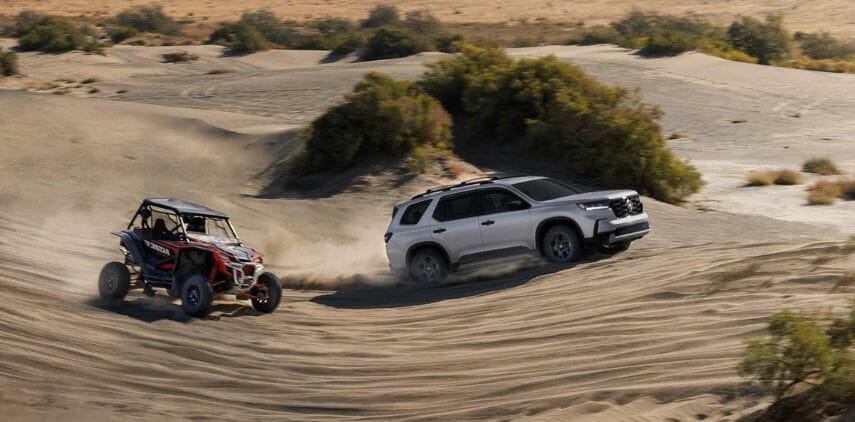Overview
The first sport utility vehicle, or SUV, was a revolutionary development in the automotive industry. It changed how people thought about cars and paved the way for other manufacturers to create versions of this popular type of vehicle.
The very first SUV was introduced in 1984 by Jeep with its Cherokee model and quickly became a hit among drivers who wanted something more rugged than a sedan but still had all the comforts of a car.
Since then, SUVs have become incredibly popular worldwide due to their versatility and off-road capabilities.
In this article, we’ll explore how it all began with an overview of what made the original Jeep Cherokee so unique and why it kickstarted one of today’s biggest automobile trends.
Table of Contents
What Was the First American SUV?
The first American SUV, considered by many automotive historians, was the Chevrolet Suburban. Introduced in 1935, the Suburban was initially designed as a versatile vehicle for carrying passengers and cargo.
It was built on a truck chassis and featured a station wagon body style. Due to its spaciousness and rugged capabilities, the Suburban became popular among various consumer groups, including families, law enforcement agencies, and commercial enterprises.
Notable features of the early Suburban models included:
- A robust frame and suspension system can handle heavy loads and off-road conditions.
- Seating capacity for up to eight passengers offers ample space for people and luggage.
- A powerful engine for its time, typically a six-cylinder unit, providing sufficient power for towing and hauling.
The Chevrolet Suburban paved the way for the development of future American SUVs, setting a precedent for combining utility, passenger comfort, and off-road capabilities.
Was the Bronco the First SUV?
No, the Bronco was not the first SUV. While the Ford Bronco, introduced in 1966, is renowned for its off-road capabilities and distinctive design, it came after the initial development of the Chevrolet Suburban. The Bronco, however, played a significant role in popularizing the concept of a sporty and rugged utility vehicle.
What Was the First 4-Door SUV?
The first 4-door SUV is often credited to the Jeep Cherokee, introduced in 1984. The Cherokee revolutionized the SUV market by combining a traditional SUV’s ruggedness and off-road capabilities with the convenience and versatility of a 4-door body style.
The 4-door configuration provided easier access to the rear seats, making it more practical for families and larger groups.
Key features of the Jeep Cherokee:
- Unibody construction offered improved handling and comfort compared to traditional body-on-frame SUVs.
- Available four-wheel drive system for enhanced off-road performance.
- Ample cargo space and seating for up to five passengers.
The Jeep Cherokee’s success as the first mass-produced 4-door SUV paved the way for developing many other 4-door models.
Who Developed the First SUV?

The development of the first SUV is attributed to several manufacturers and their respective models. Here are some notable contributions:
- The Chevrolet Suburban, introduced by General Motors in 1935, is considered the first American SUV.
- The Willys-Overland company played a significant role in developing early SUVs, particularly with the introduction of the Jeep Wagoneer in 1963.
- International Harvester released the Scout in 1961, often regarded as one of the earliest SUVs.
It’s important to note that the concept of an SUV evolved gradually over time, with various manufacturers contributing to the development and refinement of this vehicle category.
Which Car Is the Dad or the SUV?
The International Harvester Scout is often called the “dad” of SUVs. Introduced in 1961, the Scout was one of the early pioneers in the SUV segment. It combined the versatility and off-road capabilities of a traditional 4×4 truck with the comfort and utility of a station wagon. The Scout’s success laid the foundation for future SUV models, influencing the design and functionality of subsequent vehicles in this category.
Who Is the Daddy of All SUVs?
The Land Rover Range Rover is often called the “daddy” of all SUVs. Introduced in 1970, the Range Rover set new standards for luxury, refinement, and off-road capability in the SUV segment. Its ruggedness, premium features, and advanced engineering made it a trailblazer in the industry.
The Range Rover established the concept of a luxury SUV, influencing the development of numerous upscale SUV models that followed.
Did Jeep Invent the SUV?
While Jeep played a crucial role in developing and popularizing SUVs, it is not accurate to say that Jeep invented the SUV. Jeep made significant contributions to the SUV segment through the production of the Willys MB during World War II and the subsequent introduction of civilian Jeep models.
The Jeep brand became synonymous with rugged off-road vehicles, and their models, such as the Jeep Wagoneer and Jeep Cherokee, helped shape the modern SUV market. However, the concept of an SUV evolved with contributions from multiple manufacturers.
What Was the First Luxury SUV?

The Range Rover, introduced by Land Rover in 1970, is widely regarded as the first luxury SUV. It combined premium features, refined styling, and advanced off-road capabilities, setting a new standard for luxury in the SUV segment.
The Range Rover’s success paved the way for other luxury automakers to enter the SUV market, leading to the proliferation of high-end SUV models from brands like Mercedes-Benz, BMW, and Audi.
Examples of luxury SUV models that followed the Range Rover include:
- Mercedes-Benz G-Class
- BMW X5 and X7
- Audi Q7 and Q8
These vehicles offered a blend of luxury, cutting-edge technology, and powerful performance, catering to discerning customers seeking luxury and versatility in their SUVs.
What Was the SUV That Turned into a Truck?
The Chevrolet Avalanche is an example of an SUV that transformed into a truck. Introduced in 2001, the Avalanche was based on the Chevrolet Suburban platform and combined the comfort and interior space of an SUV with the functionality of a pickup truck.
Its unique feature was the “Midgate,” which allowed the rear cabin wall to be folded down, extending the truck bed into the passenger area.
Key features of the Chevrolet Avalanche:
- Flexible cargo space could be expanded by folding down the Midgate and rear seats.
- Available four-wheel drive system for off-road capability.
- Towing capacity is similar to a traditional pickup truck.
The Avalanche provided customers with a versatile vehicle that could accommodate passengers and large cargo items, making it a popular choice for those needing the functionality of a truck combined with the comfort and convenience of an SUV.
The Evolution of SUVs: From Utility to Lifestyle Vehicles
Since their early days, SUVs have come a long way as utilitarian vehicles primarily used for off-road adventures and heavy-duty tasks.
Over the years, they have undergone significant transformations over the years, evolving into popular lifestyle vehicles catering to diverse consumer preferences. Let’s explore the key stages in the evolution of SUVs:
1. Early Utility:
- The Chevrolet Suburban, Jeep Cherokee, and International Harvester Scout were among the pioneers in the SUV segment, focusing on ruggedness, versatility, and off-road capabilities.
- These early SUVs were designed for practicality, with body-on-frame construction, powerful engines, and spacious interiors for passengers and cargo.
2. Family-Friendly Appeal:
- Automakers recognized the potential for attracting family-oriented buyers as the SUV market expanded.
- The introduction of the 4-door SUV, exemplified by the Jeep Cherokee, marked a turning point in making SUVs more accessible and convenient for families.
- These models featured improved comfort, increased passenger capacity, and additional safety features, catering to the needs of larger groups.
3. Luxury and Refinement:
- The Land Rover Range Rover was a game-changer, introducing the concept of a luxury SUV to the market.
- Luxury automakers embraced the SUV trend, offering premium features, exquisite craftsmanship, and advanced technology in their SUV models.
- These upscale SUVs combined opulent interiors, smooth and powerful engines, and cutting-edge safety and entertainment systems, appealing to customers seeking both luxury and versatility.
4. Crossover Revolution:
- In the late 1990s and early 2000s, a new breed of SUVs, known as crossovers, emerged.
- Crossovers were built on car platforms, providing a more car-like driving experience with better fuel efficiency and handling than traditional SUVs.
- They offered a blend of SUV styling, spaciousness, and versatility, appealing to consumers who desired the practicality of an SUV without sacrificing comfort and fuel economy.
5. Performance and Sportiness:
- As SUVs gained popularity, automakers recognized the demand for sporty and high-performance variants.
- Performance-oriented SUVs, often equipped with powerful engines, advanced suspension systems, and aerodynamic styling, became prevalent.
- Examples include the Porsche Cayenne, BMW X5 M, and Mercedes-AMG GLE models, which combine the practicality of an SUV with exhilarating performance and dynamic handling.
6. Electric and Hybrid SUVs:
- Automakers have introduced electric and hybrid SUVs to their lineups with a growing emphasis on environmental sustainability.
- These eco-friendly SUVs aim to reduce emissions and offer improved fuel efficiency while providing the space and versatility associated with SUVs.
- Models such as the Tesla Model X, Toyota RAV4 Hybrid, and Audi e-tron exemplify this shift toward electrification in the SUV segment.

Conclusion: The Ever-Expanding SUV Market
SUVs have become a dominant force in the automotive industry, continually evolving to meet consumers’ changing demands and preferences. From their humble beginnings as rugged utility vehicles, SUVs have transitioned into versatile and luxurious lifestyle vehicles, offering various options to suit various needs and tastes.
Whether off-road capability, family-friendly features, luxury and refinement, performance-oriented driving, or eco-consciousness, the SUV market continues to expand with innovative models that cater to every lifestyle.






